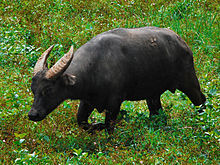| Tamaraw | |
|---|---|

| |
| In the Mounts Iglit-Baco National Park, Philippines | |
| Scientific classification | |
| Domain: | Eukaryota |
| Kingdom: | Animalia |
| Phylum: | Chordata |
| Class: | Mammalia |
| Order: | Artiodactyla |
| Family: | Bovidae |
| Subfamily: | Bovinae |
| Genus: | Bubalus |
| Species: | B. mindorensis
|
| Binomial name | |
| Bubalus mindorensis (Heude, 1888)
| |

| |
| Range map in green | |
The tamaraw or Mindoro dwarf buffalo (Bubalus mindorensis) is a small buffalo belonging to the family Bovidae.[3] It is endemic to the island of Mindoro in the Philippines, and is the only endemic Philippine bovine. It is believed, however, to have once also thrived on the larger island of Luzon. The tamaraw was originally found all over Mindoro, from sea level up to the mountains (2000 m above sea level), but because of human habitation, hunting, and logging, it is now restricted to only a few remote grassy plains and is now a critically endangered species.[1]

Contrary to common belief and past classification, the tamaraw is not a subspecies of the water buffalo, nor is it a subspecies of the slightly larger carabao, which is classified as a subspecies of the water buffalo. In contrast to the carabao, the tamaraw has a number of distinguishing characteristics; it is slightly hairier, has light markings on its face, is not gregarious, and has shorter horns that are somewhat V-shaped.[4] It is the second-largest native terrestrial mammal in the country, next only to the carabao.
- ^ a b Boyles, R.; Schutz, E.; de Leon, J. (2016). "Bubalus mindorensis". IUCN Red List of Threatened Species. 2016: e.T3127A50737640. doi:10.2305/IUCN.UK.2016-2.RLTS.T3127A50737640.en. Retrieved November 13, 2021.
- ^ "Appendices | CITES". cites.org. Retrieved January 14, 2022.
- ^ "Bubalus mindorensis". Integrated Taxonomic Information System. Retrieved March 17, 2007.
- ^ Fuentes, Art (February 21, 2005). "The Tamaraw: Mindoro's endangered treasure". Haribon. Haribon Foundation for the Conservation of Natural Resources. Retrieved March 17, 2007.
